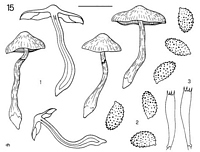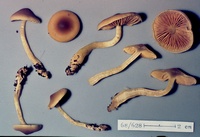|
 Dermocybe icterinoides Dermocybe icterinoides
SynonymsCortinarius icterinoides
BiostatusPresent in region - Indigenous. Endemic
Images (click to enlarge)
Caption: Dermocybe icterinoides: 1. carpophores. - 2. spores. - 3. basidia. | 
Caption: ZT68-628 , Holotype
Owner: E. Horak: © Creative Commons Attribution-Noncommercial 3.0 New Zealand |
Article: Horak, E. (1988) [1987]. New species of Dermocybe (Agaricales) from New Zealand. Sydowia 40: 81-112.
Description: Pileus - 0 mm, hemispherical-convex with conspicuous conical papilla or umbonate-campanulate; golden yellow with distinct brownish or sooty tinge over apex, olive colour shades none; dry, slightly viscid only when moist, innately fibrillose to glabrous, scarcely hygrophanous, margin rarely striate, distinct veil remnants absent. - Lamellae 12-20, -7, emarginate, subdecurrent with tooth, -5 mm wide; bright golden yellow (without olive tinges) turning yellow-rust brown in mature specimens; edges concolorous, entire or serrulate. - Stipe -55 x -4 (-6) mm, fusoid, slender, rarely cylindrical, single; dry, concolorous with lamellae or paler, longitudinally fibrillose, cortina evanescent, solid becoming hollow. - Context yellow. - Odour and taste raphanoid. - Chemical reactions on pileus: KOH - orange-brown to red-brown, slowly turning black.
Spore print rust brown. - Spores 7-9 x 4.5-S µm, ovoid to subelliptical, minutely verrucose, warts slightly coarser at apex, perisporial remnants none. - Basidia 25-35 x 6-8 µm, 4-spored, often with red-brown plasmatic pigment. - Cheilocystidia absent. - Pileipellis a cutis (or trichoderm) composed of cylindrical hyphae (3-6 µm diam.), membranes weakly gelatinized or not at all, withred-brown (to purple) encrusting and plasmatic pigment, scarcely dissolving in KOH (solvent stains pale olive-brown with purple tinge). - Clamp connections present.
Habitat: On soil in Nothofagus- forests. - New Zealand.
Notes: On carpophores of D. icterinoides bright golden yellow colours predominate on all parts. Applying KOH on the surface of pileus or stipe these conspicuous pigments immediately turn red-brown or brown. Concerning quality and quantity of the anthraquinones involved this species shares its major pigments (skyrin, endocrocin, hypericin and dermolutein) with D. alienata. On chromatograms of the former species, however, two further, yet unidentified compounds are detected. Summing up all distinctive pigment characters there is much evidence that the two taxa must have close taxonomic relationships. In addition the size and the shape of spores are almost identical and the KOH-reaction of D. alienata is also reported to be red or red-brown (KELLER & al., 1988).
The two taxa are separated, however, by the absence of olive colours on the pileus and the dry (or much less gelatinised) pileipellis in D. icterinoides.
|